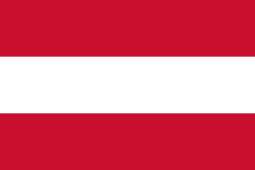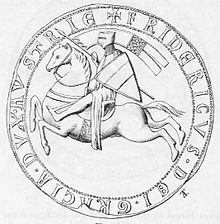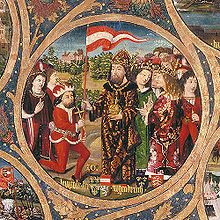
The House of Babenberg was a noble dynasty of Austrian Dukes and Margraves. Descending from the Popponids and originally from Bamberg in the Duchy of Franconia, the Babenbergs ruled the imperial Margraviate of Austria from its creation in 976 AD until its elevation to a duchy in 1156, and from then until the extinction of the line in 1246, whereafter they were succeeded by the House of Habsburg.

Styria is an Austrian state in the southeast of the country. With an area of approximately 16,399 km2 (6,332 sq mi), Styria is Austria's second largest state, after Lower Austria. It is bordered to the south by Slovenia, and clockwise, from the southwest, by the other Austrian states of Carinthia, Salzburg, Upper Austria, Lower Austria, and Burgenland. The state's capital is Graz, the second largest city in Austria after only Vienna.

Ottokar II, the Iron and Golden King, was a member of the Přemyslid dynasty who reigned as King of Bohemia from 1253 until his death in 1278. He also held the titles of Margrave of Moravia from 1247, Duke of Austria from 1251, and Duke of Styria from 1260, as well as Duke of Carinthia and landgrave of Carniola from 1269.
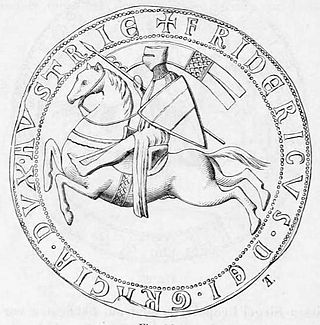
Frederick II, known as Frederick the Quarrelsome, was Duke of Austria and Styria from 1230 until his death. He was the fifth and last Austrian duke from the House of Babenberg, since the former margraviate was elevated to a duchy by the 1156 Privilegium Minus. He was killed in the Battle of the Leitha River, leaving no male heirs.

Margaret of Austria, a member of the House of Babenberg, was German queen from 1225 until 1235, by her first marriage with King Henry (VII), and Queen of Bohemia from 1253 to 1260, by her second marriage with King Ottokar II.
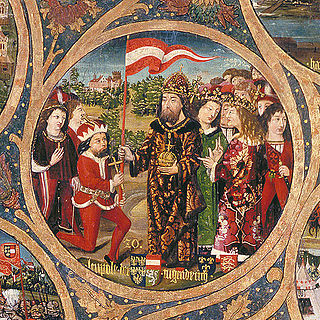
Leopold V, known as the Virtuous was a member of the House of Babenberg who reigned as Duke of Austria from 1177 and Duke of Styria within the Holy Roman Empire from 1192 until his death. The Georgenberg Pact resulted in Leopold being enfeoffed with Styria by Roman-German Emperor Frederick Barbarossa in 1193, which would lead to the eventual creation of modern Austria. Leopold was also known for his involvement in the Third Crusade where he fought in the Siege of Acre in 1191 and of his imprisonment of King Richard I in 1193 at Dürnstein Castle.

The Georgenberg Pact was a treaty signed between Duke Leopold V of Austria and Duke Ottokar IV of Styria on 17 August 1186 at Enns Castle on the Georgenberg mountain.

Gertrude of Austria was a member of the House of Babenberg, Duchess of Mödling and later titular Duchess of Austria and Styria. She was the niece of Duke Frederick II of Austria, the last male member of the Babenberg dynasty. She was, according to the Privilegium Minus decree the first in line to inherit the Duchies of Austria and Styria after the death of childless Frederick, but these claims were disputed by her aunt Margaret of Austria, Queen of Bohemia.
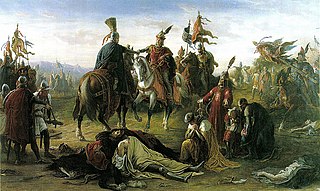
The Battle on the Marchfeld ; Polish: Bitwa pod Suchymi Krutami at Dürnkrut and Jedenspeigen took place on 26 August 1278 and was a decisive event for the history of Central Europe for the following centuries. The opponents were a Bohemian (Czech) army led by the Přemyslid king Ottokar II of Bohemia and the German army under the German king Rudolph I of Habsburg in alliance with King Ladislaus IV of Hungary. With 15,300 mounted troops, it was one of the largest cavalry battles in Central Europe during the Middle Ages. The Hungarian cavalry played a significant role in the outcome of the battle.
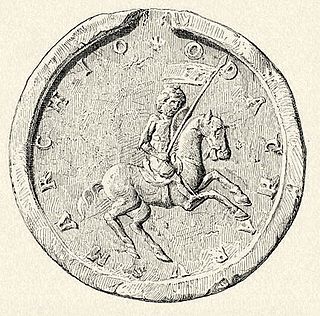
Ottokar IV, a member of the Otakar dynasty, was Margrave of Styria from 1164 and Duke from 1180, when Styria, previously a margraviate subordinated to the stem duchy of Bavaria, was raised to the status of an independent duchy.

The Otakars were a medieval dynasty ruling the Imperial March of Styria from 1056 to 1192.
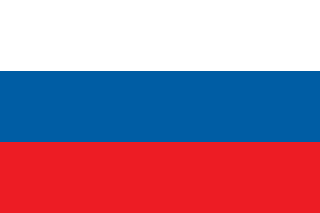
The Duchy of Carniola was an imperial estate of the Holy Roman Empire, established under Habsburg rule on the territory of the former East Frankish March of Carniola in 1364. A hereditary land of the Habsburg monarchy, it became a constituent land of the Austrian Empire in 1804 and part of the Kingdom of Illyria until 1849. A separate crown land from 1849, it was incorporated into the Cisleithanian territories of Austria-Hungary from 1867 until the state's dissolution in 1918. Its capital was Laibach, today Ljubljana.
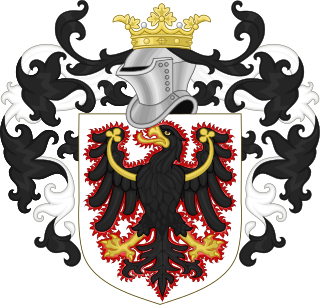
The Přemyslid dynasty or House of Přemysl was a Bohemian royal dynasty that reigned in the Duchy of Bohemia and later Kingdom of Bohemia and Margraviate of Moravia, as well as in parts of Poland, Hungary and Austria.

The Duchy of Austria was a medieval principality of the Holy Roman Empire, established in 1156 by the Privilegium Minus, when the Margraviate of Austria (Ostarrîchi) was detached from Bavaria and elevated to a duchy in its own right. After the ruling dukes of the House of Babenberg became extinct in male line, there was as much as three decades of rivalry on inheritance and rulership, until the German king Rudolf I took over the dominion as the first monarch of the Habsburg dynasty in 1276. Thereafter, Austria became the patrimony and ancestral homeland of the dynasty and the nucleus of the Habsburg monarchy. In 1453, the archducal title of the Austrian rulers, invented by Duke Rudolf IV in the forged Privilegium Maius of 1359, was officially acknowledged by the Habsburg emperor Frederick III.

The March of Styria, originally known as Carantanian march, was a southeastern frontier march of the Holy Roman Empire. It was broken off the larger March of Carinthia, itself a march of the Duchy of Bavaria, around 970 as a buffer zone against the Hungarian invasions. Under the overlordship of the Carinthian dukes from 976 onwards, the territory evolved to be called Styria, so named for the town of Steyr, then the residence of the Otakar margraves. It became an Imperial State in its own right, when the Otakars were elevated to Dukes of Styria in 1180.

The Duchy of Styria was a duchy located in modern-day southern Austria and northern Slovenia. It was a part of the Holy Roman Empire until its dissolution in 1806 and a Cisleithanian crown land of Austria-Hungary until its dissolution in 1918.

Since the days of Rudolph of Habsburg and the 1283 Treaty of Rheinfelden, the combination of red-white-red was widely considered to be the Austrian colours used by the ruling Habsburg dynasty. Black and gold later became the colours used by the Imperial House of Habsburg when they held the title of Holy Roman Emperor, as they did from the mid-15th century all the way to the dissolution of the Holy Roman Empire in 1806, and were themselves derived from the banner of the empire. The original form of this flag featured a gold background with a black double-headed eagle. However, this proved to be a complicated design, and was hard to reproduce. In the 18th century, a simpler form with black and gold bars started to appear in the lands ruled by the Holy Roman Emperor. With the end of the Holy Roman Empire in 1806, this flag was approved for use as a civil flag. The black–gold flag was used in a way similar to a modern national flag by the Austrian Habsburg monarchy within the Holy Roman Empire, by the later Austrian Empire, and by the Austrian part of Austria-Hungary, and was sometimes informally used for the entire empire, up until 1918.

The flag of Tuscany is the official flag of the region of Tuscany, Italy. The flag depicts a silver Pegasus rampant on a white field between two horizontal red bands. The flag first appeared as a gonfalon on 20 May 1975 along with accompanying text Regione Toscana above the Pegasus. It was officially adopted as the flag of Tuscany on 3 February 1995.

The Coat of arms of Styria is the historic coat of arms of the region of Styria, a federal state of Austria. It shows a white heraldic panther with red horns and claws breathing red fire on a green field. The shield is crowned with the ducal hat of Styria. The coat of arms is also used in several municipal arms of the state, including Graz and Steyr.
